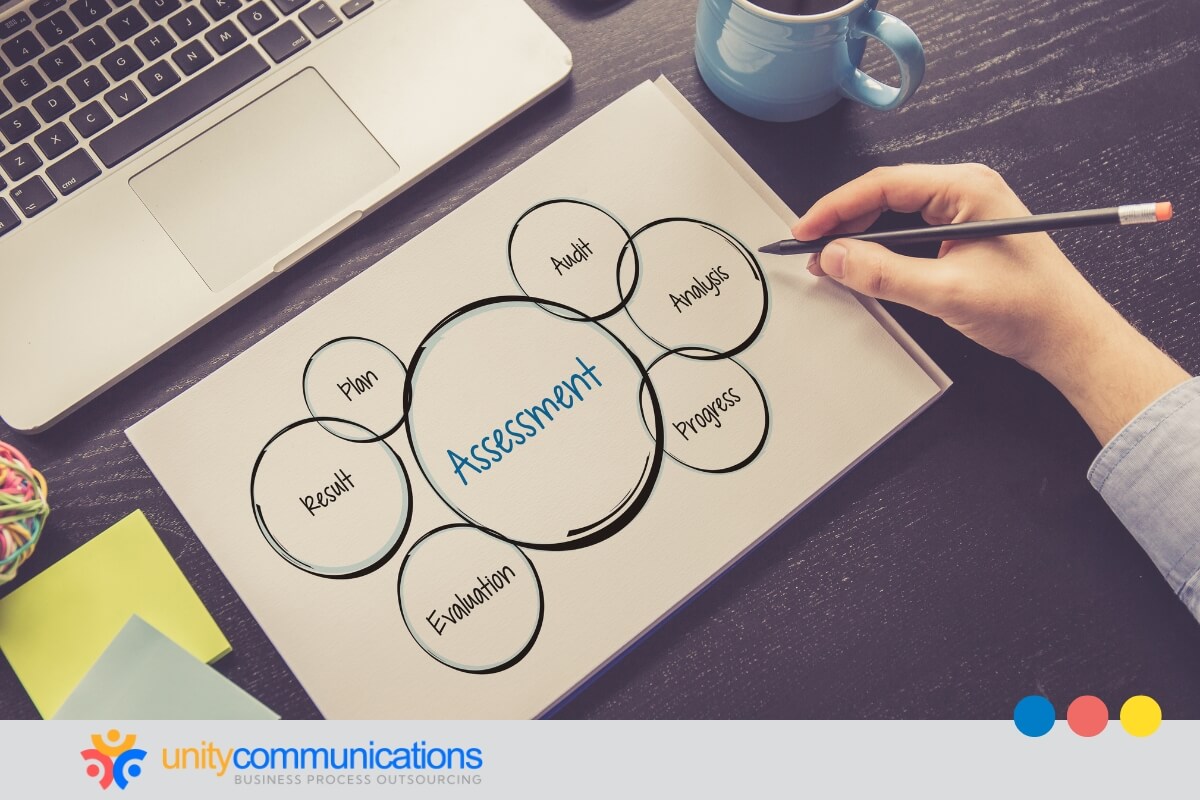Table of Contents
Customer satisfaction is essential to business growth. However, consumers nowadays require speed and personalization in customer service. Companies turn to business process outsourcing (BPO) to meet these demands and guarantee client happiness.
This article explores the crucial procedures for leveraging BPO for real-time customer support, from assessment to measurement. Keep reading to learn how to adopt a strategic approach to outsourcing.
Assessing your need for real-time customer support

What is BPO, and why is it popular among organizations? BPO is contracting a third-party service provider to manage specific business tasks. Companies across all industries leverage outsourcing to reduce operating costs and improve focus on core competencies.
Customer support is among the most outsourced business functions. It dominates the global BPO market and could sustain it until 2030. Despite this popularity, you must assess your customer service environment before venturing into BPO.
Analyze key metrics such as customer satisfaction, average handle time, first contact resolution rate, and customer churn. Determine the areas that need significant BPO assistance with these questions:
- Are you experiencing high call volumes during peak hours?
- Do your customers feel irritated by long wait times?
- Is your staff prepared to manage complicated consumer issues promptly?
- Can your staff quickly manage complicated consumer issues?
If you answered yes to any of these questions, outsourcing real-time customer support services could be a game changer for your business.
Selecting a reliable BPO provider for real-time customer support
Excellent customer service can save company resources and generate more revenue. It can increase profitability by 1% to 2% and sales revenue by 2% to 7%. Choosing the right BPO partner is crucial to the success of your real-time support initiatives.
Consider the following factors when finding a BPO company capable of enhancing client satisfaction and ensuring seamless operations:
1. Industry expertise
Choose a vendor with extensive experience and knowledge about your sector, including your target market and your company’s challenges. If you have an e-commerce business, search for a supplier with experience in high-volume, time-sensitive client interactions.
2. Technology stack
Examine the BPO firm’s technological infrastructure and ensure they use cutting-edge tools. Sophisticated customer relationship management (CRM) systems, live chat platforms, and omnichannel capabilities allow clients to interact seamlessly with your business across several channels.
For example, a BPO firm can utilize artificial intelligence (AI)-driven chatbots to address basic inquiries so live support agents can handle more complex problems. This approach delivers a comprehensive and efficient customer service experience.
3. Scalability
Your business needs might fluctuate, especially during peak periods or expansion. Choose a BPO partner capable of scaling their operations to meet these demands without compromising service quality.
For example, if your business experiences a surge in customer inquiries during the holiday season, your provider should be able to quickly increase support capacity to handle the increased calls.
4. Quality assurance
Quality control maintains high service standards. Inquire about the BPO firm’s quality assurance processes and performance metrics. A provider that conducts regular audits, monitors customer interactions, and uses feedback to drive continuous improvement makes a valuable partner.
For example, a BPO company with a dedicated team tracking key performance indicators (KPIs) such as first-call resolution rates and customer satisfaction scores can provide consistent and reliable service.
5. Data security
Protecting sensitive customer information is critical to maintaining trust, compliance, and reputation. Ensure the BPO provider has robust data security protocols, including end-to-end encryption and compliance with industry standards such as the General Data Protection Regulation (GDPR) or the Health Insurance Portability and Accountability Act of 1996 (HIPAA).
For instance, a secure choice would be a provider that regularly updates its cybersecurity measures and performs vulnerability assessments to safeguard customer data.
By thoroughly evaluating these factors and selecting a BPO vendor that aligns with your business needs, you can establish a strong foundation for delivering exceptional real-time customer support.
Integrating real-time support technologies with BPO services

To deliver seamless real-time support, integrate the following technologies with your BPO partner’s services:
- Live chat. Offer instant messaging capabilities to address customer inquiries swiftly and efficiently. Initiate chats based on customer behavior or website activity to anticipate needs and link customers’ chat histories to customer profiles for personalized interactions.
- Customer relationship management (CRM) systems. Consolidate customer information (demographics, purchase history, and preferences) for a holistic view. Provide agents with real-time access to customer data for informed interactions. Utilize data to forecast customer needs and tailor support accordingly.
- Knowledge bases. Empower customers to find answers independently through searchable knowledge bases. Equip agents with up-to-date product or service information for accurate responses while gathering feedback on knowledge base effectiveness to refine content.
- Social media monitoring tools. Track customer mentions, sentiments, and emerging issues across social platforms and promptly address these concerns and inquiries. Leverage social listening to identify and mitigate potential crises.
- Call recording and analysis. Monitor agent interactions to ensure compliance with standards and identify training needs. Analyze call metrics, including average handle time and first call resolution, to measure agent productivity. Identify recurring customer issues and trends to improve products and services.
Customizing support solutions to fit business needs
Every business is unique, so tailor your real-time support solution to your requirements. Consider the following tips:
- Customer profiles. According to HubSpot, personalization boosts sales and urges repeat purchases. Develop detailed customer personas to understand needs and preferences.
- Multichannel support. Determine which channels (phone, email, chat, social media) are most important to your customers. Provide support across multiple touchpoints to accommodate diverse customer preferences and optimize channel performance. Use analytics to identify areas for improvement and allocate resources effectively.
- Service-level agreements (SLAs). Outline specific performance targets for response times, resolution rates, and customer satisfaction. Align SLAs with customer expectations and business priorities. Continuously track performance against SLAs to identify trends and areas for improvement.
- Issue escalation procedures. Define clear guidelines, roles, and responsibilities for handling complex issues. Equip agents to resolve most cases independently, with clear escalation paths for complex situations. Streamline processes to minimize customer wait times and frustration.
Training BPO staff for effective real-time customer support

Invest in comprehensive training programs to equip BPO agents with the skills and knowledge to excel in real-time customer support. Focus on the following areas:
- Product knowledge. Deepen agents’ understanding of your products or services.
- Customer service skills. Teach effective communication, problem-solving, and empathy techniques.
- Technology proficiency. Provide BPO training on CRM systems, live chat platforms, and other relevant tools.
- Company culture. Communicate your brand values and expectations for customer interactions.
Implementing real-time monitoring and quality assurance
About 55% of consumers share their purchases on social media, which can influence the decisions of 81% of U.S. consumers. This shows the significance of maintaining high-quality customer service.
Guarantee service quality by implementing robust monitoring and quality assurance programs. Utilize call recording, screen sharing, and customer surveys to evaluate agent performance.
Additionally, measure the following crucial KPIs:
- Customer satisfaction (CSAT) indicates how satisfied the consumer is with the transaction.
- Customer effort score (CES) evaluates how easy it was for clients to get a solution for their problems.
- Net promoter score (NPS) helps determine advocacy and consumer loyalty.
- Average handle time (AHT) measures the duration of customer interactions.
By identifying strengths and shortcomings, you can collaborate with the BPO project managers to deliver tailored coaching and feedback and improve agent skills and service performance.
Integrating customer feedback into support operations

Customer feedback is crucial for improving support. Gathering insights from surveys, social media, and other channels can help you understand customer experiences. Analyzing this feedback identifies areas for improvement, leading to better support strategies and increased customer satisfaction.
Here’s how to effectively leverage customer feedback:
- Centralize feedback repository. Collect feedback from various channels (surveys, social media, emails) in a centralized location.
- Analyze sentiments. Use tools to identify trends and patterns in customer feedback.
- Prioritize feedback. Focus on addressing issues with the highest impact on customer satisfaction.
- Create a feedback loop. Share feedback with agents and teams to drive improvements. Respond to customer feedback directly to express that their input is valued.
- Track feedback implementation. Measure the impact of changes made based on customer feedback.
Combining metrics, strategies, and client feedback creates a culture of continuous improvement, leading to enhanced customer satisfaction and loyalty.
The bottom line
Staying ahead requires agility and adaptability in today’s rapidly evolving customer service landscape. You must harness the power of data and technology to deliver personalized, real-time support.
Partnering with a BPO expert elevates your customer service operations to drive customer loyalty and business growth. This collaboration allows you to understand your specific challenges and develop a tailored strategy that contributes to outstanding customer experiences.
Ready to elevate your customer service? Let’s connect today!




